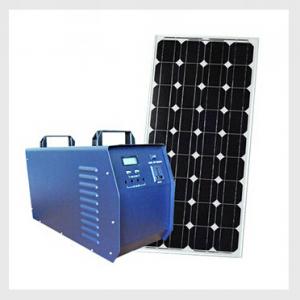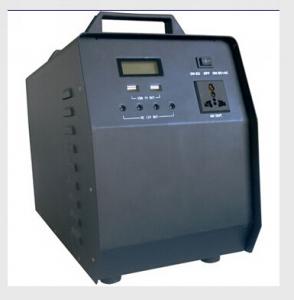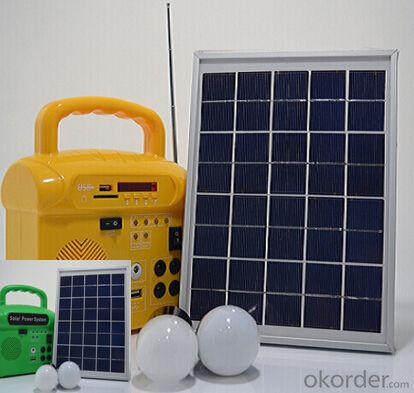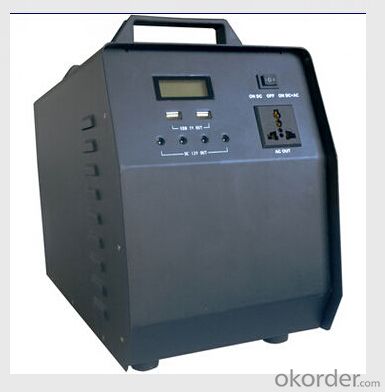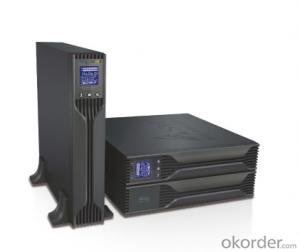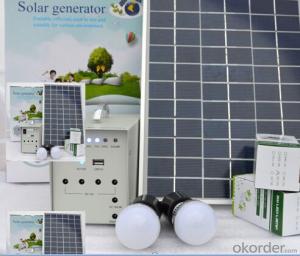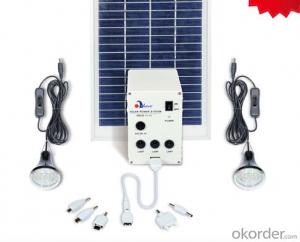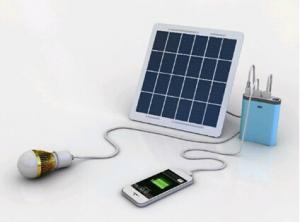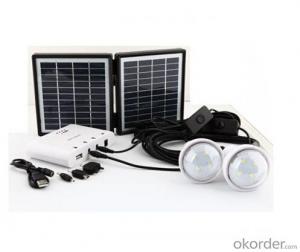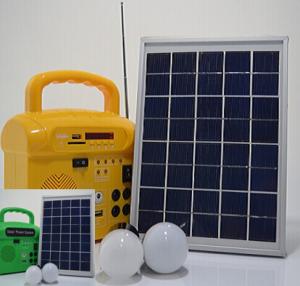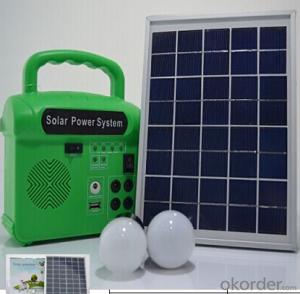Solar Energy Systems Gold Coast - CNBM Solar Home System Roof System Capacity-5w-1
- Loading Port:
- China Main Port
- Payment Terms:
- TT or LC
- Min Order Qty:
- 500 set
- Supply Capability:
- 10000 set/month
OKorder Service Pledge
OKorder Financial Service
You Might Also Like
Introduction of Solar Home System
A home solar power system is a great way to save money by reducing or even eliminating your electricity bill. In recent times the price and cost of installing a home solar power system in Australia has continued to fall, this is mostly due to an increase in demand, more efficient solar panel manufacturing techniques and advances in solar cell technology. As the price of fossil fuel generated electricity continues to rise, many more Australian homes are making the solar switch over and enjoying the true value solar energy can provide.
It is very good for indoor use where there is shortage of electricity and for outdoor activities such as picnicking, fishing and camping. It is an ideal tool for Motor Mechanics, Farm House and small shop owners such as Hairdressers, Barbers, Cobblers, Tailors and Kiosk keepers.

Working Principle of Solar Roof System
The stand alone Solar Home System is an off-grid solar system which uses batteries to store the solar energy. Stand alone solar system solutions design for those who are not able or willing to connect to electricity grid.
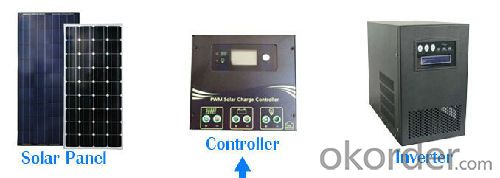
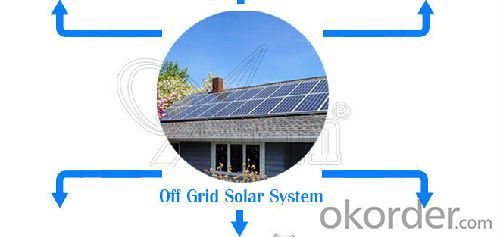

Specification of Solar Home System
Solar panel : 18V, 5W
Rechargeable battery: lead acid,12V,4Ah,maintenance-free
Lamp:led lamp, DC 12V, 20LED(1W) per lamp,lamp holder ,total 2pcs
Wire lead : 5m with DC connector
Function: over charge/discharge protection/short circuit protection
Lighting mode: constantly
Charging time: 6-8hours
Output voltage: DC 5V,DC12V,
Qutantity of carton: 3pc
Carton size: 36.5*30.5*575px
Product Features of Solar Home System
Off grid solar power system is mainly used for application with relatively-small power consumption, and the areas have no grid network coverage, or grid power is unstable or outage condition.
It’s composed of solar panels, hybrid solar inverter, battery bank, solar panel mounting racks, and other accessories required fora complete home solar power system.
The battery bank gives a stable power output to the solar inverter which converts DC to AC to power loads, and provides power backup in rainy or cloudy days.
The solar panels generate electricity at daytime and charge the battery bank.
The off grid home solar power system provides grid power bypass in case of battery power shortage when sunshine is not enough.
All the off grid home solar power system configurations are worked out by scientific calculation and design.
Advantage of Our Solar Home System
1.Safety and easy installation,Plug and play systems;
2.Good quality panel to ensure the high efficiency and long life needs;
3.Solar Automatic lighting controller :with adjustable run times, over-current protection;
4.Solar Batteries: Maintenance free, long life batteries
5.Lighting Source: LED lamp /Lantern (Fixed/Movable)
6.Flexible designs per client requests;
Terms and Conditions
1. Trade terms: FOB Shanghai
2. Payment terms: 30% T/T, balanced before shipment/ LC at sight before shipment. Actual Terms can be negotiated for big order.
3. Package: Exported standard package suitable for tough handling and sea transport.
4. Delivery: Goods to be ready within 10~30 days depending on order quantity.
5. Warranty: 10 years for solar panel, 2 years for controller/inverter/battery.
FAQ
Q: Could you introduce the background of your company?
A: We are a Group corp. with 1GW capacity in China, which is Okorder’s registered VIP Supplier, possess Financial Service from Okorder.com.
Q: Required mainly certificates (CE&IEC/TUV/RoHS)?
A: Our products are certificated by CE RoHS, IEC, ISO, TUV, UL etc.
Q: Your main exported market is?
A: Main markets of our products is: South-east Asia, Mid-east, Arica, East Europe and Latin America.
- Q: Can a solar energy system be installed on a building with a slate roof?
- Installing a solar energy system on a building with a slate roof is indeed possible. However, there are certain factors to consider and precautions to take into account due to the unique nature of the slate roof. Properly distributing and supporting the weight of the solar panels and mounting system is crucial to avoid any potential damage. Moreover, the installation team must exercise extra caution to prevent any cracks or breakages in the slate tiles during the process. To ensure a safe and successful installation, it is highly recommended to collaborate with experienced professionals who specialize in installing solar energy systems on slate roofs.
- Q: How do solar energy systems impact regional economic development?
- Solar energy systems have a positive impact on regional economic development. They create new job opportunities in the installation, maintenance, and manufacturing sectors. These systems also attract private investment, stimulate local businesses, and reduce electricity costs for industries and households. Additionally, solar energy systems contribute to a cleaner environment, which can attract tourism and enhance the overall image of the region.
- Q: Can solar energy systems be used for powering oil and gas extraction operations?
- Yes, solar energy systems can be used for powering oil and gas extraction operations. In fact, the use of solar energy in the oil and gas industry has been gaining traction in recent years. Solar power can be utilized to provide electricity for various operations such as pumping, drilling, and processing. It is particularly beneficial in remote areas where access to the grid may be limited or expensive. Solar energy systems can reduce the carbon footprint of oil and gas extraction operations by minimizing the reliance on fossil fuels for power generation. Additionally, solar power can lower operational costs in the long run, as it offers a more sustainable and cost-effective alternative to traditional energy sources.
- Q: Can solar energy systems be used to power homes?
- Yes, solar energy systems can be used to power homes. Solar panels capture sunlight and convert it into electricity, which can then be used to power various appliances and systems within a home. This sustainable and renewable energy source can provide a reliable and cost-effective alternative to traditional utility electricity.
- Q: Can a solar energy system be used in cold climates?
- Yes, a solar energy system can be used in cold climates. While it is true that solar panels are most efficient in sunny and warm conditions, they can still generate electricity in cold climates. In fact, solar panels can even perform better in colder temperatures due to their ability to convert sunlight into electricity more efficiently. Additionally, snowfall on solar panels can be beneficial as it acts as a natural cleaner, reflecting more sunlight onto the panels and increasing their efficiency. However, it's essential to consider the angle and position of the panels to ensure they receive optimal sunlight throughout the year. Overall, with proper installation and maintenance, solar energy systems can be effectively utilized in cold climates to generate clean and renewable energy.
- Q: Can solar energy systems be used in powering construction sites or temporary structures?
- Solar energy systems are certainly capable of powering construction sites or temporary structures. In fact, the utilization of solar power in these situations is growing due to its many advantages. To begin with, construction sites often lack access to conventional power sources, making solar energy a practical solution. Solar panels can be easily installed on rooftops, scaffolding, or even on the ground, providing a dependable source of electricity throughout the construction process. Moreover, solar energy systems offer flexibility in power generation. They can be tailored to meet the specific energy demands of construction sites, whether it be for powering tools, lighting, or charging equipment. This adaptability ensures that construction activities can proceed seamlessly without any disruptions. Additionally, solar energy systems are environmentally friendly. By harnessing energy from the sun, construction sites can significantly reduce their carbon footprint and contribute to sustainable practices. Solar power does not generate harmful emissions or noise pollution, which is particularly advantageous in urban areas or sensitive environments. Furthermore, solar energy systems provide long-term cost savings. Although the initial investment for installing solar panels might be higher compared to traditional generators, the ongoing operational costs are substantially lower. Construction sites can benefit from reduced fuel expenses, maintenance costs, and a reduced reliance on fossil fuels. It is worth noting that solar energy systems can also be utilized for temporary structures such as mobile offices, portable restrooms, or event venues. These structures can be conveniently powered using solar panels, eliminating the need for generators or grid connections. In conclusion, solar energy systems are a practical and sustainable choice for powering construction sites and temporary structures. They offer reliable, customizable, and cost-effective power solutions while minimizing the impact on the environment. As the global shift towards renewable energy continues, solar power is likely to become even more prevalent in the construction industry.
- Q: Can solar energy systems be used in areas with limited access to healthcare facilities?
- Yes, solar energy systems can be used in areas with limited access to healthcare facilities. Solar energy can power medical equipment, refrigeration units for vaccines and medications, lighting for healthcare facilities, and other essential healthcare services. By providing a reliable and sustainable source of electricity, solar energy systems can help overcome the challenges of limited access to healthcare facilities in remote or underdeveloped areas.
- Q: Can a solar energy system be installed on a warehouse or industrial facility?
- Yes, a solar energy system can be installed on a warehouse or industrial facility. In fact, these types of buildings often have large roof spaces or open areas that are ideal for installing solar panels. This can help the facility reduce its dependence on traditional energy sources, lower electricity costs, and contribute to a more sustainable and environmentally friendly operation.
- Q: Can a solar energy system be installed on a government building or facility?
- Yes, a solar energy system can be installed on a government building or facility. In fact, many governments around the world have been actively promoting and implementing renewable energy initiatives, including solar power, on their buildings and facilities. Installing solar panels on government buildings not only helps to reduce carbon emissions and reliance on fossil fuels but also sets an example for the community and encourages the adoption of clean energy technologies. Additionally, solar energy systems can help governments save money on electricity bills in the long run and provide a more sustainable and resilient energy source. Overall, the installation of solar energy systems on government buildings is a viable and increasingly popular option for promoting clean energy and combating climate change.
- Q: Can solar energy systems be used in areas with frequent snowfall?
- Yes, solar energy systems can still be used in areas with frequent snowfall. While snow can reduce the efficiency of solar panels, it does not render them completely useless. Proper design and maintenance can help ensure that snow is quickly cleared from the panels, allowing them to continue generating electricity. Additionally, advancements in technology and the use of tilt mounting systems can also improve their performance in snowy conditions.
Send your message to us
Solar Energy Systems Gold Coast - CNBM Solar Home System Roof System Capacity-5w-1
- Loading Port:
- China Main Port
- Payment Terms:
- TT or LC
- Min Order Qty:
- 500 set
- Supply Capability:
- 10000 set/month
OKorder Service Pledge
OKorder Financial Service
Similar products
Hot products
Hot Searches
Related keywords
